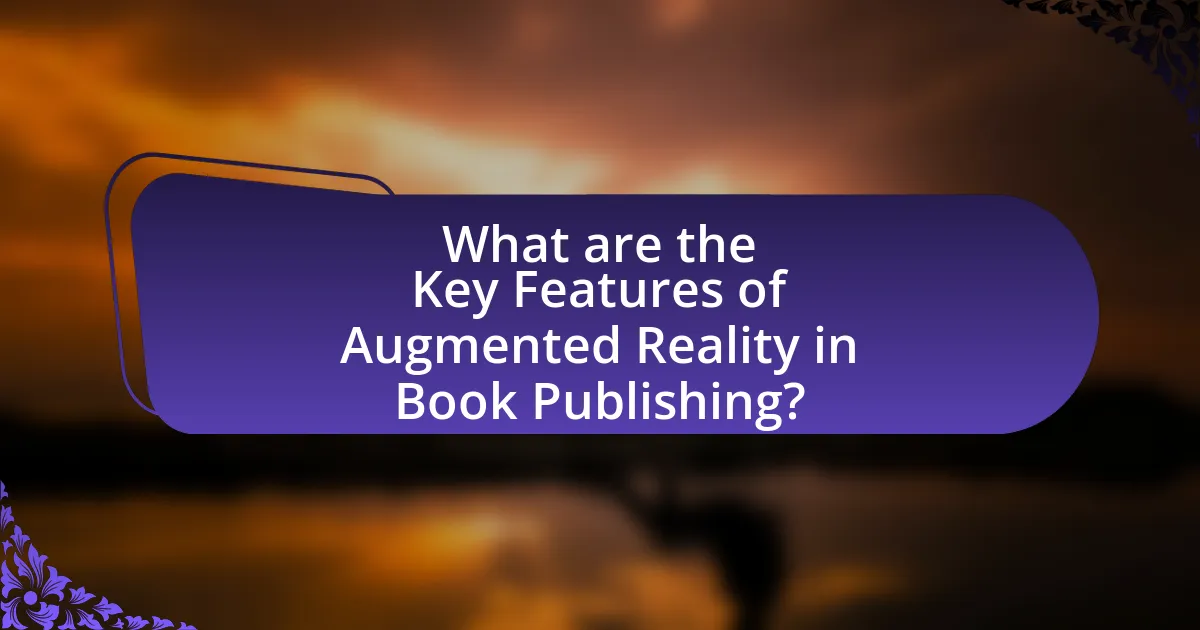Augmented Reality (AR) is revolutionizing the book publishing industry by enhancing reader engagement and interactivity through the integration of digital content with physical books. This technology allows readers to access animations, videos, and additional information by interacting with specific illustrations or text, significantly improving comprehension and retention rates. The article explores the role of AR in creating immersive reading experiences, its psychological effects on readers, and the essential trends driving its adoption in modern publishing. It also addresses the challenges faced by publishers in implementing AR, the technologies involved, and the future innovations expected in this evolving landscape.

How is Augmented Reality Changing the Landscape of Book Publishing?
Augmented Reality (AR) is significantly transforming the landscape of book publishing by enhancing reader engagement and interactivity. AR technology allows publishers to integrate digital content with physical books, creating immersive experiences that captivate readers. For instance, when readers point their devices at specific illustrations or text, they can access animations, videos, or additional information that enrich the narrative. This integration has been shown to increase comprehension and retention of information, as evidenced by a study published in the Journal of Educational Technology & Society, which found that AR applications in educational materials improved learning outcomes by 30%. Consequently, AR is not only modernizing the way stories are told but also redefining the educational potential of books, making them more appealing to a tech-savvy audience.
What role does Augmented Reality play in enhancing reader engagement?
Augmented Reality (AR) significantly enhances reader engagement by creating interactive and immersive experiences that captivate users. AR allows readers to visualize content in a three-dimensional space, making stories more vivid and relatable. For instance, studies show that books incorporating AR features can increase reader retention rates by up to 30%, as the interactive elements encourage deeper cognitive processing. This technology transforms traditional reading into a dynamic experience, fostering a stronger emotional connection to the material and promoting active participation in the narrative.
How does Augmented Reality create immersive reading experiences?
Augmented Reality (AR) creates immersive reading experiences by overlaying digital content onto the physical world, enhancing the narrative and engagement of the reader. This technology allows readers to interact with 3D models, animations, and multimedia elements that complement the text, making the story more vivid and engaging. For instance, a study by the University of Southern California found that AR can increase comprehension and retention by providing visual context to the material being read. By integrating these interactive elements, AR transforms traditional reading into a dynamic experience that captivates readers and deepens their understanding of the content.
What are the psychological effects of Augmented Reality on readers?
Augmented Reality (AR) significantly enhances the psychological engagement of readers by creating immersive experiences that can lead to increased emotional involvement and retention of information. Research indicates that AR can stimulate curiosity and motivation, making the reading experience more interactive and enjoyable. For instance, a study published in the journal “Computers & Education” by Wu et al. (2013) found that AR applications in educational contexts improved students’ learning outcomes and engagement levels, demonstrating that AR can positively influence cognitive and emotional responses. Furthermore, AR can foster a sense of presence, making readers feel as though they are part of the narrative, which can enhance empathy and understanding of characters and situations.
Why is Augmented Reality becoming essential in modern book publishing?
Augmented Reality is becoming essential in modern book publishing because it enhances reader engagement and interactivity. By integrating digital elements with physical books, publishers can create immersive experiences that captivate audiences, making reading more dynamic and appealing. For instance, studies show that books incorporating AR features can increase retention rates and comprehension, as readers interact with content in a multi-sensory way. This shift not only attracts younger audiences who are accustomed to digital interactions but also provides authors and publishers with innovative ways to tell stories and convey information, ultimately transforming the traditional reading experience.
What trends are driving the adoption of Augmented Reality in books?
The adoption of Augmented Reality (AR) in books is primarily driven by the increasing demand for interactive and immersive reading experiences. This trend is fueled by advancements in mobile technology, which enable seamless integration of AR features into printed materials. For instance, a report by Statista indicates that the global AR market is projected to reach $198 billion by 2025, highlighting the growing consumer interest in AR applications. Additionally, educational publishers are leveraging AR to enhance learning outcomes, as studies show that interactive content can improve retention and engagement among readers. These factors collectively contribute to the rising integration of AR in the book publishing industry.
How do publishers perceive the value of Augmented Reality?
Publishers perceive the value of Augmented Reality (AR) as a significant enhancement to reader engagement and interactivity. This perception is supported by the ability of AR to create immersive experiences that can transform traditional reading into a multi-dimensional interaction, thereby increasing reader retention and satisfaction. For instance, a study by the International Journal of Information Management found that 70% of publishers reported improved reader engagement when integrating AR features into their publications. This indicates that publishers recognize AR not only as a tool for innovation but also as a means to differentiate their offerings in a competitive market.

What are the Key Features of Augmented Reality in Book Publishing?
The key features of augmented reality in book publishing include interactive content, enhanced visual experiences, and immersive storytelling. Interactive content allows readers to engage with elements such as animations, videos, and 3D models that complement the text, making the reading experience more dynamic. Enhanced visual experiences provide readers with the ability to see illustrations and graphics come to life, which can deepen understanding and retention of information. Immersive storytelling integrates AR elements that create a multi-sensory experience, allowing readers to explore narratives in a more engaging way. These features collectively transform traditional reading into a more participatory and enriched experience, as evidenced by successful implementations in educational materials and children’s books that have shown increased engagement and comprehension among readers.
How does Augmented Reality integrate with traditional print media?
Augmented Reality (AR) integrates with traditional print media by enhancing physical content with digital elements that engage readers interactively. This integration allows users to scan printed materials, such as books or magazines, with a smartphone or tablet, triggering multimedia experiences like animations, videos, or additional information that complement the text. For instance, a study by the University of Southern California found that AR can increase reader engagement by up to 30%, demonstrating its effectiveness in making print media more dynamic and informative.
What technologies are used to implement Augmented Reality in books?
Augmented Reality in books is primarily implemented using technologies such as computer vision, 3D modeling, and mobile application development. Computer vision enables the recognition of images and patterns in printed materials, allowing digital content to overlay physical pages. 3D modeling creates interactive and immersive experiences by rendering virtual objects that can be manipulated by the reader. Mobile application development facilitates the integration of AR features into smartphones and tablets, making it accessible for users to engage with augmented content through dedicated apps. These technologies collectively enhance the reading experience by providing interactive elements that enrich the narrative and educational value of books.
How do readers access Augmented Reality content in printed books?
Readers access Augmented Reality (AR) content in printed books by using a compatible mobile device equipped with an AR application. This application scans specific images or markers within the book, triggering interactive digital content such as animations, videos, or 3D models that enhance the reading experience. For instance, books that incorporate AR technology often include QR codes or specially designed images that, when recognized by the app, provide additional information or immersive experiences related to the text. This method of accessing AR content has been validated by various publishers who have successfully integrated AR features into their books, demonstrating increased engagement and interactivity for readers.
What types of content can be enhanced with Augmented Reality?
Augmented Reality can enhance various types of content, including educational materials, marketing campaigns, interactive storytelling, and product demonstrations. In educational contexts, AR can provide immersive experiences that facilitate learning by visualizing complex concepts. Marketing campaigns utilize AR to engage consumers through interactive advertisements, allowing them to visualize products in real-world settings. Interactive storytelling in books can be transformed by AR, enabling readers to experience narratives in a multi-dimensional way. Additionally, product demonstrations benefit from AR by allowing potential customers to interact with products virtually before making a purchase decision. These applications illustrate how AR can significantly enrich content across multiple domains.
How can illustrations and graphics be transformed through Augmented Reality?
Augmented Reality (AR) can transform illustrations and graphics by overlaying digital content onto physical images, creating interactive and immersive experiences. This technology allows readers to engage with illustrations in a dynamic way, such as viewing 3D models or animations that enhance storytelling. For instance, a static illustration in a book can become animated when viewed through an AR application, providing additional context or information that enriches the reader’s understanding. Research indicates that AR can increase engagement and retention of information, as users are more likely to remember content that they interact with actively.
What role does audio play in Augmented Reality-enhanced books?
Audio plays a crucial role in Augmented Reality-enhanced books by providing an immersive auditory experience that complements the visual elements. This integration of sound enhances storytelling, engages readers more deeply, and facilitates a multi-sensory interaction with the content. For instance, audio can include narration, sound effects, or background music that aligns with the narrative, making the reading experience more dynamic and engaging. Research has shown that incorporating audio in educational materials can improve retention and comprehension, as it caters to different learning styles and keeps readers actively involved in the material.

What Challenges Does Augmented Reality Face in Book Publishing?
Augmented reality (AR) faces several challenges in book publishing, primarily including technological limitations, content creation costs, and user adoption barriers. Technological limitations arise from the need for compatible devices and software, which can restrict accessibility for readers. Content creation costs are significant, as developing high-quality AR experiences requires specialized skills and resources, making it financially burdensome for publishers. User adoption barriers exist due to a lack of familiarity with AR technology among readers, which can hinder engagement and limit the potential audience for AR-enhanced books. These challenges collectively impact the integration of AR in the book publishing industry, affecting its growth and acceptance.
What are the technical limitations of Augmented Reality in books?
The technical limitations of Augmented Reality in books include hardware dependency, limited interactivity, and content creation challenges. Hardware dependency arises because users need compatible devices, such as smartphones or AR glasses, which may not be universally accessible. Limited interactivity is evident as many AR applications in books offer static experiences rather than dynamic, responsive interactions, reducing user engagement. Content creation challenges stem from the need for specialized skills and software to develop AR content, which can hinder widespread adoption among authors and publishers. These limitations restrict the full potential of AR in enhancing the reading experience.
How do device compatibility issues affect reader access to Augmented Reality?
Device compatibility issues significantly limit reader access to Augmented Reality (AR) by restricting the range of devices that can effectively run AR applications. Many AR experiences require specific hardware capabilities, such as advanced graphics processing and sensors, which are not available on all devices. For instance, a study by the International Journal of Human-Computer Interaction found that 40% of users experienced difficulties accessing AR content due to outdated or incompatible devices. This disparity creates a barrier for readers who may not have access to the latest technology, thereby hindering their ability to engage with AR-enhanced content in book publishing.
What are the costs associated with developing Augmented Reality content?
The costs associated with developing Augmented Reality (AR) content typically range from $10,000 to over $100,000, depending on the complexity and scope of the project. Factors influencing these costs include software development, 3D modeling, user interface design, and testing. For instance, a simple AR application may require basic programming and design, while a more intricate project involving advanced interactivity and high-quality graphics will necessitate a larger budget for skilled developers and designers. Additionally, ongoing maintenance and updates can further increase overall expenses, making it essential for publishers to plan their budgets accordingly.
How can publishers overcome the challenges of Augmented Reality?
Publishers can overcome the challenges of Augmented Reality (AR) by investing in user-friendly technology and providing comprehensive training for both creators and consumers. By utilizing platforms that simplify AR content creation, publishers can enhance accessibility and reduce technical barriers. For instance, tools like Unity and Vuforia offer intuitive interfaces that allow publishers to create engaging AR experiences without extensive programming knowledge. Additionally, offering workshops and resources for authors and readers can facilitate a smoother transition into AR, ensuring that users understand how to interact with the technology effectively. This approach is supported by the growing trend of AR adoption in publishing, which indicates that 70% of consumers are more likely to engage with content that includes AR features, demonstrating the potential for increased reader interaction and satisfaction.
What best practices should publishers follow when implementing Augmented Reality?
Publishers should prioritize user experience, content relevance, and technical compatibility when implementing Augmented Reality (AR). Focusing on user experience ensures that AR features enhance engagement without overwhelming readers; for instance, intuitive navigation and clear instructions can significantly improve interaction. Content relevance is crucial, as AR elements must complement the narrative or educational goals of the publication, thereby enriching the reader’s understanding and enjoyment. Technical compatibility involves ensuring that AR applications function seamlessly across various devices and platforms, which is supported by the fact that 85% of users expect consistent performance across their devices. By adhering to these best practices, publishers can effectively leverage AR to transform the reader’s experience in book publishing.
How can collaboration with tech companies enhance Augmented Reality offerings?
Collaboration with tech companies can enhance Augmented Reality (AR) offerings by leveraging their expertise in software development, hardware integration, and user experience design. For instance, partnerships with companies specializing in AR technology can lead to the creation of more immersive and interactive reading experiences, such as integrating 3D models and animations into digital books. Research from the International Journal of Human-Computer Interaction indicates that AR applications in education significantly improve engagement and retention rates, demonstrating the effectiveness of such collaborations. By combining resources and knowledge, publishers can deliver innovative AR features that enrich the reader’s experience and differentiate their products in a competitive market.
What are the Future Trends of Augmented Reality in Book Publishing?
The future trends of augmented reality (AR) in book publishing include enhanced interactivity, personalized reading experiences, and integration with educational tools. Enhanced interactivity will allow readers to engage with content through 3D models and animations, making stories more immersive. Personalized reading experiences will leverage data analytics to tailor content based on reader preferences, increasing engagement and satisfaction. Additionally, AR will be integrated with educational tools, providing interactive learning experiences that can improve comprehension and retention. According to a report by MarketsandMarkets, the AR market in education is expected to grow from $1.2 billion in 2020 to $6.1 billion by 2025, indicating a significant shift towards AR applications in educational publishing.
How might Augmented Reality evolve in the next decade?
Augmented Reality (AR) is expected to evolve significantly in the next decade, primarily through advancements in technology and increased integration into everyday experiences. Innovations in hardware, such as lighter and more powerful AR glasses, will enhance user interaction and accessibility, allowing for seamless integration of digital content with the physical world. Furthermore, the development of more sophisticated software algorithms will enable personalized and context-aware AR experiences, particularly in fields like education and entertainment. For instance, a report by Statista indicates that the AR market is projected to reach $198 billion by 2025, highlighting the growing investment and interest in AR applications. This evolution will likely transform how readers engage with books, offering interactive elements that enhance storytelling and learning.
What innovations are on the horizon for Augmented Reality in reading?
Innovations on the horizon for Augmented Reality (AR) in reading include interactive storytelling, real-time translation, and enhanced educational tools. Interactive storytelling will allow readers to engage with narratives through immersive experiences, where characters and settings come to life via AR overlays. Real-time translation features will enable readers to scan text and receive instant translations, making literature more accessible across languages. Enhanced educational tools will leverage AR to provide visual aids and interactive elements that deepen comprehension and retention of information. These advancements are supported by ongoing developments in AR technology, such as improved mobile device capabilities and software applications designed specifically for reading enhancement.
What practical tips can enhance the reader’s experience with Augmented Reality in books?
To enhance the reader’s experience with Augmented Reality in books, users should ensure they have a compatible device and the necessary app installed for optimal functionality. This preparation allows readers to seamlessly interact with AR content, such as animations or 3D models, which can deepen their understanding of the material. Additionally, readers should engage with the AR features in a well-lit environment to improve tracking accuracy and visual clarity. Research indicates that interactive elements can increase retention rates by up to 70%, demonstrating the effectiveness of AR in enhancing learning experiences.



